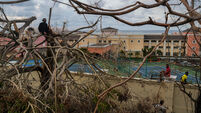Film stuntmen aim for space snatch-and-grab
A space capsule holding atoms collected from solar wind was en route to a tricky rendezvous with Earth today, offering scientists the first material Nasa has brought back from space in nearly three decades.
A pair of helicopters crewed by stunt pilots were set to hover nearly a mile above the Utah desert, ready to help snatch the refrigerator-sized capsule’s parachute with a hook as it floats down at 400 feet a minute
“All systems are go,” Don Sevilla, Genesis payload recovery leader, said Tuesday when the capsule was 134,000 miles (above the Earth’s surface. If all goes as planned, the mid-air capture was to take place today.
The capsule’s charged atoms – a “billion billion” of them – should reveal clues about the origin and evolution of our solar system, said Don Burnett, Genesis principal investigator and a nuclear geochemist at California Institute of Technology.
“We have for years wanted to know the composition of the sun,” Burnett said. “In some cases we will be analysing it one atom at a time.”
Genesis has been moving in tandem with Earth outside its magnetic shield on three orbits of the sun. It was to pick up speed rapidly as Earth’s gravitational pull brings it closer before the atmosphere abruptly slows the descent.
That’s when the helicopters take over.
Both Cliff Fleming, the lead helicopter pilot, and backup pilot Dan Rudert have replicated the retrieval in dozens of practice runs, and will have five chances to snag the capsule.
If they fail, it will hit the ground and shatter the fragile disks holding the atoms. Once captured, the capsule will be tethered to a cable to cushion the impact.
Fleming and Rudert, stunt pilots by trade, were drafted for the €223.3m mission because of their expertise flying high and capturing objects.
Fleming has swooped after sky surfers in the action movie XXX and towed actor Pierce Brosnan through the air in Dante’s Peak. He has also just finished working on Batman 4.
Fleming said the current job is tricky since he won’t have any visual reference to judge the speed or distance of the 400-pound capsule as he closes in from behind it. Among the risks are a sudden updraft that could entangle the capsule’s parachute in his tail rotor.
“Because you’re up nearly in space, you can’t see the wind,” Fleming he said. ”There’s no movement of trees or brush or dust, so that makes it difficult.”
The Genesis mission, launched in 2001, marks the first time Nasa has collected and returned any objects from farther than the moon.













